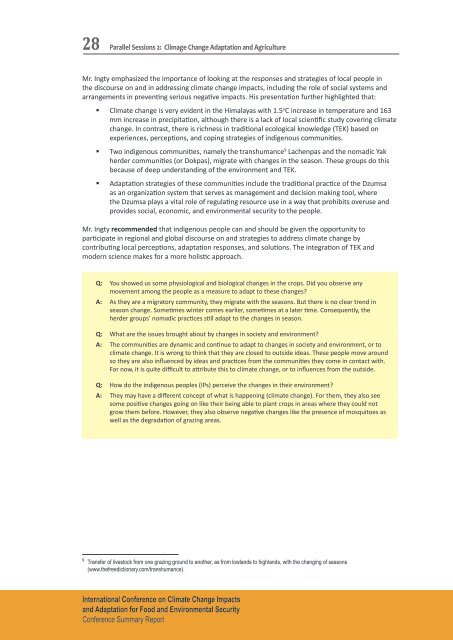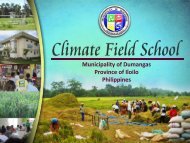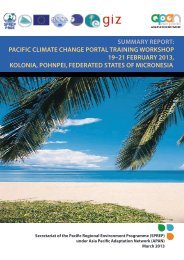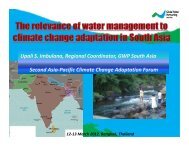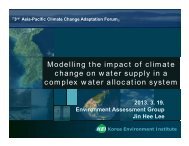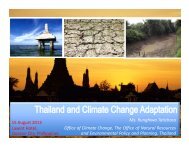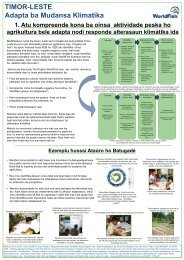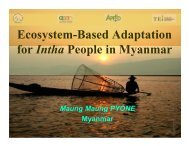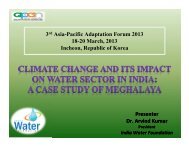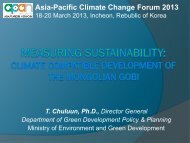PDF file (2.44 MB) - Asia Pacific Adaptation Network
PDF file (2.44 MB) - Asia Pacific Adaptation Network
PDF file (2.44 MB) - Asia Pacific Adaptation Network
Create successful ePaper yourself
Turn your PDF publications into a flip-book with our unique Google optimized e-Paper software.
28Parallel Sessions 2: Climage Change <strong>Adaptation</strong> and AgricultureMr. Ingty emphasized the importance of looking at the responses and strategies of local people inthe discourse on and in addressing climate change impacts, including the role of social systems andarrangements in preventing serious negative impacts. His presentation further highlighted that:• Climate change is very evident in the Himalayas with 1.5 o C increase in temperature and 163mm increase in precipitation, although there is a lack of local scientific study covering climatechange. In contrast, there is richness in traditional ecological knowledge (TEK) based onexperiences, perceptions, and coping strategies of indigenous communities.• Two indigenous communities, namely the transhumance 9 Lachenpas and the nomadic Yakherder communities (or Dokpas), migrate with changes in the season. These groups do thisbecause of deep understanding of the environment and TEK.• <strong>Adaptation</strong> strategies of these communities include the traditional practice of the Dzumsaas an organization system that serves as management and decision making tool, wherethe Dzumsa plays a vital role of regulating resource use in a way that prohibits overuse andprovides social, economic, and environmental security to the people.Mr. Ingty recommended that indigenous people can and should be given the opportunity toparticipate in regional and global discourse on and strategies to address climate change bycontributing local perceptions, adaptation responses, and solutions. The integration of TEK andmodern science makes for a more holistic approach.Q: You showed us some physiological and biological changes in the crops. Did you observe anymovement among the people as a measure to adapt to these changes?A: As they are a migratory community, they migrate with the seasons. But there is no clear trend inseason change. Sometimes winter comes earlier, sometimes at a later time. Consequently, theherder groups’ nomadic practices still adapt to the changes in season.Q: What are the issues brought about by changes in society and environment?A: The communities are dynamic and continue to adapt to changes in society and environment, or toclimate change. It is wrong to think that they are closed to outside ideas. These people move aroundso they are also influenced by ideas and practices from the communities they come in contact with.For now, it is quite difficult to attribute this to climate change, or to influences from the outside.Q: How do the indigenous peoples (IPs) perceive the changes in their environment?A: They may have a different concept of what is happening (climate change). For them, they also seesome positive changes going on like their being able to plant crops in areas where they could notgrow them before. However, they also observe negative changes like the presence of mosquitoes aswell as the degradation of grazing areas.9 Transfer of livestock from one grazing ground to another, as from lowlands to highlands, with the changing of seasons(www.thefreedictionary.com/transhumance).International Conference on Climate Change Impactsand <strong>Adaptation</strong> for Food and Environmental SecurityConference Summary Report


